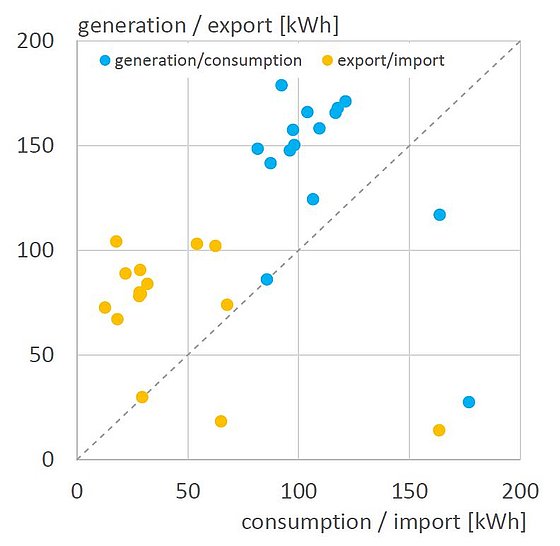Energy flexibility

Electrical energy balances of the 16 houses at SDE 21/22 during the competition period. Almost all houses achieved a positive balance of generation and consumption.
One feature of the energy transition is a strongly growing share of renewable energies in the electricity grid. Since electricity generation from wind and sun is not uniform, there are times when there is a high supply or even surplus of green electricity and other times when there is a demand for electricity from conventional sources. Therefore, there is a temporal variation in the CO2 intensity of the electricity supply and different weighting of fed-in electricity with regard to the associated environmental impact.
In addition, the expansion of electromobility and the increase in electrically powered heating and cooling systems can temporarily overload the existing grid infrastructure. For low CO2 intensity and voltage stabilisation in the grid, consumption in suitable areas should follow generation in the future.To meet this requirement, intelligent load management systems are needed that can influence the operation of appliances, e-charging stations and air conditioning in buildings.
Battery storage in combination with a photovoltaic system on buildings increases the share of self-consumed solar power and the degree of self-sufficiency. This reduces the load on the electricity grid. However, battery storage is suitable for smoothing out power peaks in the consumption profile for the grid. Thermal storage in the provision of heating and cooling works in a similar way. With almost all types of energy storage, however, losses have to be considered, which counterbalance the advantage of flexibilisation.
In order to perform particularly favourably in the energy discipline in the SDE 21/22, a building management system is necessary that allows automatic changes in consumption and ice supply behaviour depending on a signal from the electricity grid.
Further reading
- Voss; Hendel; Stark: Solar Decathlon Europe – A review on the energy engineering of experimental solar powered houses, in: Energy and Buildings, 2021, https://www.sciencedirect.com/science/article/pii/S0378778821006204?via%3Dihub
-
Stark, M.: Energy Flexible Buildings, IEA EBC Annex 74 "Competition and Living Lab Platform", 2020, https://building-competition.org/technicaldoc/show/TOPA
- Energieflexible Gebäude, https://www.annex67.org/
- Energy Flexible Buildings Towards Resilient Low Carbon Energy Systems, https://annex82.iea-ebc.org/
- Quaschning, V.: Online-Rechner zur Unabhängigkeit, https://www.volker-quaschning.de/software/index_e.php
